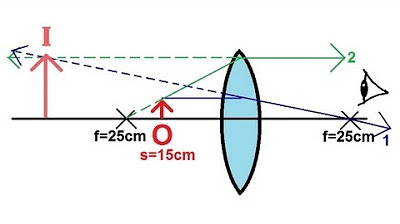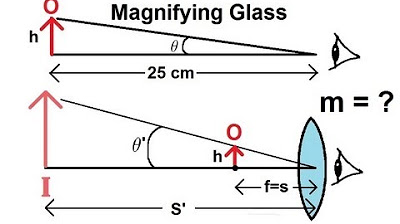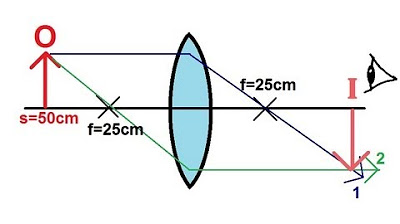The Magnifying Glass | Physics with Professor Matt Anderson | M28-10
TLDRThis educational script explores the functionality of a magnifying glass, illustrating how it enables us to see small objects more clearly. It explains the lens rules, particularly focusing on 'ray 3', which travels through the lens's center without bending. The script demonstrates that as an object is brought closer, the image size increases, but our eyes can only focus so close. By placing a magnifying glass against the eyeball, it allows the viewer to focus at a much closer distance, making the text appear larger and clearer without changing the actual image size. The magnifying glass's purpose is to extend the focusing range, providing a clear view of objects that would otherwise be too close to see clearly.
Takeaways
- 🔍 The magnifying glass is a tool used to enlarge small objects or text for better visibility.
- 👀 It demonstrates the concept of the 'bare eyeball' versus using a magnifying glass to see objects more clearly.
- 📚 The script uses the example of reading small text to explain how a magnifying glass works.
- 🌟 The lens rules are mentioned, with a focus on 'ray 3' which passes through the center of the lens and does not bend, affecting the size of the image.
- 📉 As the object is moved closer to the eye without a magnifying glass, the image gets larger but eventually becomes unfocusable.
- 👁️ Adding a lens (magnifying glass) to the eye helps to maintain the image size while bringing the object closer to the point of focus.
- 🔬 The magnifying glass is positioned right up against the eyeball to function properly, allowing for a clear, enlarged image.
- 📖 The purpose of the magnifying glass is to enable the user to focus on objects at a much closer distance than would normally be possible.
- 🤔 The script highlights the limitation of the human eye's ability to focus on objects that are very close without assistance.
- 🔄 The demonstration shows that with the magnifying glass, the text remains the same size but is brought into focus, allowing for clear reading.
- 🧐 The magnifying glass does not inherently change the size of the object; it merely allows for closer focus and a clearer view.
Q & A
What is the primary purpose of a magnifying glass?
-The primary purpose of a magnifying glass is to allow the user to see small objects or details more clearly by magnifying the image of the object.
How does a magnifying glass work in terms of lens rules?
-A magnifying glass works based on the lens rules, where ray 3, which passes through the center of the lens, does not bend, thus maintaining the same image size when the object is moved closer or further away.
Why does the image appear larger when an object is moved closer to the magnifying glass?
-The image appears larger when the object is moved closer because ray 3 comes in at a steeper angle, causing the image to be magnified as it bends more towards the focal point of the lens.
What happens when you can't focus on an object that is too close to your eye?
-When an object is too close to your eye, you can't focus on it because it exceeds the near point of your vision, causing the image to be blurry and out of focus.
How does placing a magnifying glass against the eyeball affect the image size?
-Placing a magnifying glass directly against the eyeball does not change the image size because ray 3 follows the same trajectory as if there were no lens, maintaining the original size of the image.
What is the advantage of using a magnifying glass right up against the eyeball?
-The advantage of using a magnifying glass right up against the eyeball is that it allows you to focus much closer than you normally could, providing a clear and magnified image of the object.
Why does the text appear out of focus when the magnifying glass is removed?
-The text appears out of focus when the magnifying glass is removed because the eye cannot naturally focus on objects at such close distances without the aid of the magnifying glass.
What is the relationship between the distance of an object and its perceived size when using a magnifying glass?
-The perceived size of an object when using a magnifying glass is related to its distance from the lens; the closer the object is to the lens, the larger the image appears.
Can you provide an example of how the magnifying glass helps in reading small text?
-An example of how a magnifying glass helps in reading small text is by placing the lens right up against the eye and bringing the text close, which magnifies the text and makes it clear and readable.
What is the significance of the 'near point' in the context of the magnifying glass demonstration?
-The 'near point' is significant because it is the closest distance at which the eye can focus on an object. The magnifying glass demonstration shows that beyond this point, the eye cannot focus, and the magnifying glass helps to overcome this limitation.
How does the magnifying glass differ from the natural focusing ability of the human eye?
-The magnifying glass differs from the natural focusing ability of the human eye by extending the range at which the eye can focus, allowing for the observation of objects at distances closer than the eye's near point.
Outlines
🔍 Understanding the Magnifying Glass
This paragraph explains the function of a magnifying glass, which is a tool used to enlarge the appearance of small objects or text, making them easier to see. The speaker uses a visual analogy of the 'bare eyeball' to describe how the magnifying glass works by bending light rays, particularly 'ray 3', which passes through the center of the lens without bending. The paragraph discusses how moving an object closer increases the size of the image seen through the lens, but also the point at which the image becomes too close to focus on. It emphasizes that the magnifying glass, when placed directly against the eye, allows the viewer to focus on objects at a much closer distance than would normally be possible.
👀 The Limitations of Close Focus
This paragraph continues the discussion on the limitations of focusing on objects that are too close to the eye without the aid of a magnifying glass. It highlights the point where the human eye can no longer focus on an object that is brought too near, resulting in a blurry and out-of-focus image. The speaker suggests that this is where the magnifying glass becomes particularly useful, as it extends the range at which objects can be brought into focus, thus enhancing the viewer's ability to see fine details clearly.
Mindmap
Keywords
💡Magnifying glass
💡Eyeball
💡Lens rules
💡Ray 3
💡Focus
💡Object
💡Image size
💡Angle
💡Steeper
💡Focal point
Highlights
The magnifying glass is a tool used to enlarge small objects, making them easier to see.
A magnifying glass is designed to help see small details that are not visible to the naked eye.
The lens rules are fundamental to understanding how a magnifying glass works.
Ray 3, which passes through the center of the lens, is crucial for the image formation in a magnifying glass.
As an object is moved closer to the lens, the image size increases due to the steeper angle of incidence.
The inability to focus on objects at very close distances is a limitation of the human eye.
Adding a lens to the eye, like a magnifying glass, can overcome the focusing limitations of the human eye.
The magnifying glass works by allowing the eye to focus on objects at a much closer distance than normal.
The magnifying glass does not change the size of the image when placed directly against the eye.
A powerful lens can bring text into focus at a very close distance, enhancing visibility.
The purpose of the magnifying glass is to enable clear vision of objects that are too close to focus on naturally.
The magnifying glass creates a clear, enlarged image of text when used correctly.
Without the magnifying glass, the same size image of text is out of focus and unreadable.
The demonstration shows the practical application of a magnifying glass in enhancing visual clarity.
Students are encouraged to try the magnifying glass demonstration after class for a hands-on experience.
The magnifying glass provides a clear, enlarged image only when used in a specific manner against the eye.
Transcripts
Browse More Related Video

How telescopes work | Class12 (India) | Physics | Khan Academy

Physics - Optics: Lenses (4 of 4) Converging Lens

Physics 59 Optical Instruments (1 of 20) Magnifying Glass

Physics - Optics: Vision Correction (4 of 5) Farsighted

Physics - Optics: Lenses (2 of 4) Converging Lens

Physics - Optics: Lenses (3 of 4) Converging Lens
5.0 / 5 (0 votes)
Thanks for rating: